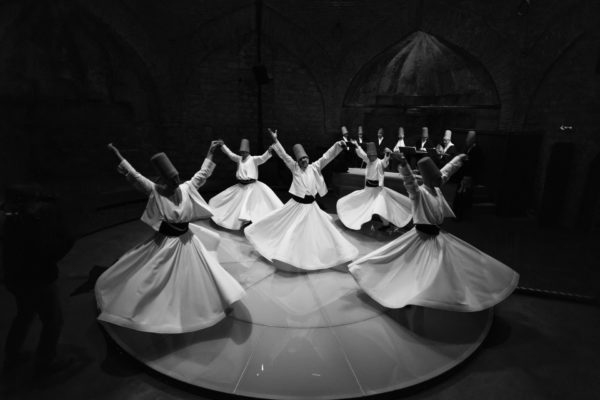Rumi’s ability to convey complex spiritual truths through simple yet profound poetry has made him a timeless figure in the history of literature and spirituality.
Rumi’s ability to convey complex spiritual truths through simple yet profound poetry has made him a timeless figure in the history of literature and spirituality.
Jalal ad-Din Muhammad Rumi, more commonly known as Rumi, is one of the most celebrated and influential mystic poets in history.
Born on September 30, 1207, in Balkh (now in Afghanistan), and later settling in Konya (present-day Turkey), Rumi’s works transcend the boundaries of geography, religion, and time. His poetry and teachings have captivated readers and scholars alike, making him a pivotal figure in the world of Sufism and Persian literature.
Early Life and Education
Rumi was born into a family of Persian-speaking scholars and theologians. His father, Baha’ ud-Din Walad, was a noted theologian and mystic, which provided Rumi with an early exposure to the spiritual and intellectual traditions of Islam.
The family’s migration from Balkh due to the Mongol invasions eventually led them to settle in Konya. Here, Rumi’s spiritual journey began in earnest under the guidance of his father and later his mentor, Burhan al-Din Muhaqqiq.
Rumi’s formal education included traditional Islamic sciences such as jurisprudence, theology, and Quranic exegesis. He was also well-versed in Persian literature and philosophy. This diverse and comprehensive education laid the foundation for his later works, which seamlessly blend theological insights with poetic expression.
Meeting Shams Tabrizi
A turning point in Rumi’s life was his encounter with Shams Tabrizi, a wandering dervish, in 1244. This meeting profoundly influenced Rumi, transforming him from a respected scholar into a passionate mystic.
Shams became Rumi’s spiritual instructor and soulmate, and their deep connection led to the creation of some of Rumi’s most profound poetry. The intensity of their relationship, however, caused friction among Rumi’s followers, eventually leading to Shams’ mysterious disappearance.
Shams introduced Rumi to the idea of divine love as the central tenet of spiritual life, encouraging him to look beyond the confines of traditional scholarship. Their relationship was characterized by intense spiritual discourse and mutual devotion, and it was during this period that Rumi began to express his mystical experiences through poetry.
The Masnavi and Other Works
Rumi’s literary output is vast and varied, with the Masnavi (or Mathnawi) being his magnum opus. Comprising six books and over 25,000 verses, the Masnavi is often referred to as the “Quran in Persian” due to its depth of spiritual insight and moral guidance. Through stories, parables, and lyrical poetry, Rumi explores themes of divine love, the human condition, and the soul’s quest for God.
The Masnavi is structured as a series of didactic stories and allegories, each conveying spiritual truths and ethical lessons. It addresses the complexities of human nature and the challenges of the spiritual path, offering guidance on how to overcome ego and achieve union with the divine.
In addition to the Masnavi, Rumi’s other significant works include the Divan-e Shams-e Tabrizi (The Collected Poems of Shams of Tabriz), which is a tribute to his beloved mentor, and the Fihi Ma Fihi (It Is What It Is), a collection of Rumi’s discourses on various spiritual topics.
The Divan-e Shams is a masterpiece of lyrical poetry, expressing the ecstatic joy and profound sorrow of Rumi’s spiritual journey. Fihi Ma Fihi provides insight into Rumi’s thoughts and teachings, capturing the essence of his spiritual philosophy in a more accessible prose format.
Themes in Rumi’s Poetry
Rumi’s poetry is characterized by its profound exploration of love, mysticism, and the nature of existence. Central to his work is the concept of divine love (ishq), which transcends earthly boundaries and unites the lover with the beloved, symbolizing the soul’s union with God. Rumi’s verses often depict the spiritual journey as one of separation and longing, culminating in ecstatic union.
Love, for Rumi, is both a metaphor for the divine and a literal path to spiritual enlightenment. His poetry often describes the pain of separation from the beloved (God) and the joy of reunion, using rich imagery and metaphors drawn from everyday life.
Another key theme is the idea of annihilation (fana) and subsistence (baqa) in God. Rumi teaches that the ego must be obliterated for the soul to fully experience divine presence. This process of self-annihilation and rebirth in the divine is a recurring motif in his work, emphasizing the transformative power of spiritual devotion.
Rumi also frequently explores the nature of the soul and its relationship with the body and the material world. He uses the metaphor of the reed flute, which mournfully longs to return to the reed bed from which it was cut, to symbolize the soul’s longing for its divine source.
Rumi’s Influence and Legacy
Rumi’s influence extends far beyond the realm of Persian literature and Sufism. His works have been translated into numerous languages, and his universal themes of love, spirituality, and humanity have resonated with people of diverse cultural and religious backgrounds. The Whirling Dervishes, a Sufi order founded by Rumi’s followers, continue to perform the sama, a ritual dance symbolizing the soul’s ascent to the divine.
In the modern era, Rumi’s poetry has found a new audience through translations by scholars like Coleman Barks, who have brought his verses to the English-speaking world. Rumi’s emphasis on love and inner transformation has also made him a popular figure in contemporary spiritual and self-help literature.
Rumi’s legacy is evident in the continued popularity of his works, which are celebrated in literary festivals, spiritual retreats, and academic conferences around the world. His teachings have inspired countless individuals to pursue a deeper understanding of themselves and their connection to the divine.
Rumi’s influence can also be seen in the works of later poets and mystics, both in the Islamic world and beyond. His ability to convey complex spiritual truths through simple yet profound poetry has made him a timeless figure in the history of literature and spirituality.
Conclusion
Rumi’s poetry and teachings offer a timeless exploration of the human soul’s quest for divine love and understanding. His works continue to inspire and guide individuals on their spiritual journeys, transcending the boundaries of time, culture, and religion.
As one of the greatest mystic poets, Rumi’s legacy endures, reminding us of the transformative power of love and the eternal quest for spiritual enlightenment.
References
- Schimmel, A. (1978). The Triumphal Sun: A Study of the Works of Jalaluddin Rumi. State University of New York Press.
- Lewis, F. (2000). Rumi: Past and Present, East and West. Oneworld Publications.
- Barks, C. (1995). The Essential Rumi. HarperOne.
- Nicholson, R.A. (1925). Rumi: Poet and Mystic (1207-1273). George Allen & Unwin Ltd.
- Chittick, W.C. (1983). The Sufi Path of Love: The Spiritual Teachings of Rumi. State University of New York Press.
- Safavi, S.M., & Weightman, S.C. (2009). Rumi’s Mystical Design: Reading the Mathnawi, Book One. State University of New York Press.
- Mojaddedi, J.A. (2004). Rumi: Bridge to the Soul. HarperOne.





